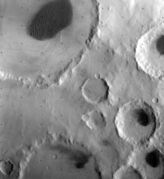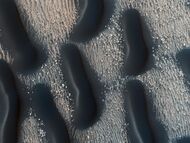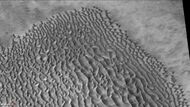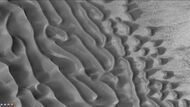Astronomy:Proctor (Martian crater)
From HandWiki
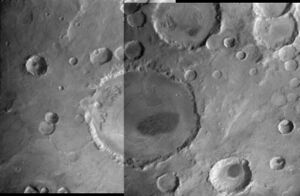 Viking Orbiter 1 mosaic | |
| Planet | Mars |
|---|---|
| Region | Noachis Terra |
| Coordinates | [ ⚑ ] : 48°00′S 330°30′W / 48°S 330.5°W |
Proctor is a large crater in the Noachis quadrangle of Mars. It measures 168.2 kilometres (104.5 miles) in diameter and was named after Richard A. Proctor, a British astronomer (1837–1888).[1]
Dune fields
The crater contains a 35 x 65 km dark dune field.[2][3] It was one of the first sand dune fields ever recognized on Mars based on Mariner 9 images.[4] The crater's dunes are being monitored by HiRISE to identify changes over time.[5]
-
Topographical map showing location of Proctor crater and other nearby craters
-
Another Viking image of the dunes in Proctor and in nearby craters
-
Proctor crater transverse aeolian ridges and Dunes, as seen by HiRISE
-
HiRISE image of the crater with transverse aeolian ridges surrounding a large dune
-
The edge of a dark dune field on the floor of Proctor crater
-
Dune field on floor of Proctor crater, as seen by CTX camera on Mars Reconnaissance Orbiter.
-
Close-up of dunes on floor of Proctor crater, as seen by CTX camera on Mars Reconnaissance Orbiter. This is an enlargement of part of previous image.
See also
- List of craters on Mars: O-Z
References
- ↑ "Gazetteer of Planetary Nomenclature | Proctor". International Astronomical Union. http://planetarynames.wr.usgs.gov/Feature/4829.
- ↑ Fenton, L. K. (2005). "Seasonal Movement of Material on Dunes in Proctor Crater, Mars: Possible Present-Day Sand Saltation". Lunar and Planetary Science XXXVI (2005). http://www.lpi.usra.edu/meetings/lpsc2005/pdf/2169.pdf.
- ↑ Mary Chapman, ed (2007). The Geology of Mars: Evidence from Earth-Based Analogs. Cambridge University Press. pp. 250. ISBN 978-0-521-83292-2.
- ↑ "Dune Activity in Proctor Crater". Mars Global Surveyor - Mars Orbiter Camera - MGS MOC Release No. MOC2-170. Malin Space Science Systems. 10 August 1999. http://www.msss.com/mars_images/moc/8_10_99_releases/moc2_170/.
- ↑ Bridges, Nathan (9 March 2009). "Sand Dunes and Ripples in Proctor Crater". HiRISE Operations Center. http://hirise.lpl.arizona.edu/ESP_011909_1320.
External links
- Nemiroff, Robert; Bonnell, Jerry (February 26, 2002). "Sand Dunes on Mars". Astronomy Photo of the Day (APOD). https://apod.nasa.gov/apod/ap010226.html.
 |

